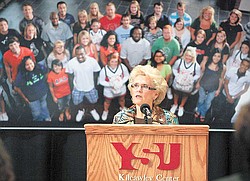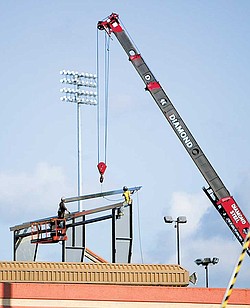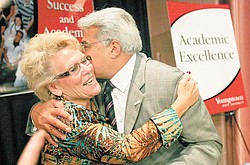Anderson: Top goal must be to meet needs of all students
By Denise Dick
In her first State of the University Address on Monday, Cynthia Anderson, Youngstown State University president, outlined some of her plans:
A focus on student success and academic excellence.
Creation of a Student Enrollment Center designed to coordinate enrollment services for better access and efficiency.
Formation of a committee, chaired by the provost and the vice president for finance and administration, to develop a strategic plan leading to 2020.
YSU playing a lead role in contributing to the economic growth and improving the quality of life for the region.
Placing a focus on computer science and technology.
Embrace green technology.
Diversity must be woven into everything at the university.
The facilities department has been assessing the internal needs of the campus.
Showcasing achievements of graduates.
A focus on students.
Source: Anderson’s speech
Anderson envisions a strategic planning process leading YSU to the year 2020. The process will involve input from “every campus colleague who chooses to contribute,” she said.
Ironworkers from Diamond Steel, Boardman, and Hively Construction, Canfi eld, put the first steel into place Monday for Youngstown State University’s $10 million WATTS (Watson and Tressel Training Site) Center.
Cynthia Anderson, Youngstown State University president, gets a hug from Ikram Khawaja, YSU’s provost and vice president for academic aff airs, after delivering her first State of the University address Monday in the Chestnut Room at Kilcawley Center.
YOUNGSTOWN
Youngstown State University needs to do a better job of identifying the needs of individual students as they arrive on campus, YSU President Cynthia Anderson told members of the faculty, staff, administration and community.
In her first State of the University address Monday in the Chestnut Room of Kilcawley Center, Anderson talked about the goals of the university to keep it moving forward.
“Meeting the needs of our students so that they may succeed in their coursework is not just an option for us — it is absolutely a necessity, as our funding is dependent on an outcome-based model,” she said.
A change in state funding now focuses on course completion and graduation as keys to securing ongoing state aid.
But Anderson said the university also needs to focus on helping students because it’s the right thing to do.
“We must identify the individual needs of our students as they come through our admissions office doors,” she said. “And we must provide them with a road map for success. That may mean some type of new administrative or college structure; or it may mean some new process.”
Anderson said she has asked Jack Fahey, interim vice president for student affairs, to lead the university in creating a student enrollment center to coordinate enrollment services for better access and efficiency.
Since the announcement last February of the board of trustees’ selection of Anderson as YSU’s seventh president, Anderson has said her focus will be on students.
She reiterated that during her speech Monday.
“I will not be in my office on Monday, Aug. 23,” Anderson said, referring to the first day of classes. “I will be out on our beautiful campus welcoming the thousands of students who chose to attend Youngstown State University and place their future in our hands.”
That met with applause from those assembled to hear the speech.
Ryan Meditz of Canfield, one of two student members of the board of trustees, said there’s been a buzz among students on campus since Anderson’s appointment.
Even before she was named president, Anderson, formerly vice president for student affairs, saw students as a priority and was visible on campus, Meditz said.
There’s been a shift from an emphasis on the importance of the administration to the importance of the students, he said.
Anderson also has asked the provost and vice president of finance and administration to lead a strategic planning process leading YSU to the year 2020.
“This is a process which will include the input of every campus colleague who chooses to contribute,” she said.
 43
43



